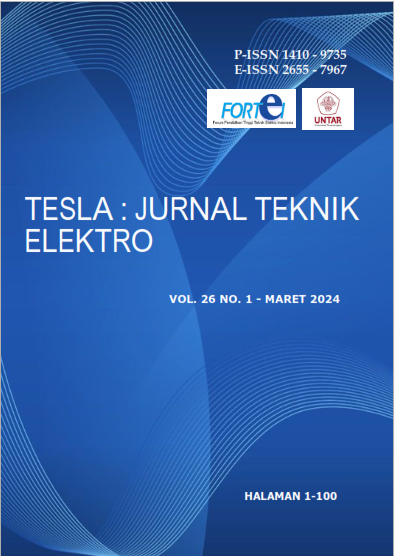AUTOMATION OF THE GREASE APPLY PROCESS TO IMPROVE THE EFFICIENCY OF USING GREASE LINE SUB ASSY PAD COMP
Main Article Content
Abstract
One aspect that needs to be paid attention to in the manufacturing industry in order to produce goods with guaranteed quality is the final process. This process is an assembly process. One of the parts that goes through the assembling process is the caliper. The caliper is an important component in disc brakes which functions to clamp the brake lining (pad comp) to the disc disc area and also to support the brake lining (pad comp) and brake piston. This comp pad will then press the disc disc so that it will create friction to stop the rotation of the disc brake. The comp pad must work optimally to be able to stop the disc brake rotation. In order for the comp pad to work optimally, it requires dampening material in the form of grease with the right quality and quantity. The applied volume of grease on the comp pad must comply with the standards for each type of comp pad. Apart from that, grease should not get on the front of the comp pad (lining) because that will make the product Not Good (NG). Therefore, an automatic grease application tool was created to increase the efficiency of grease use and the grease volume on the comp pad can be stable according to the requirements. with standards and there is no process of applying grease to parts where it is not supposed to. With this tool, the percentage of grease usage efficiency for the inner area is 0.5% and for the outer part it is 2.55%. Apart from that, there is no longer a process of applying grease to parts where it shouldn't be
Abstrak
Salah satu aspek yang perlu diperhatikan pada industri manufaktur agar menghasilkan barang dengan kualitas terjamin adalah pada proses terakhir. Proses tersebut adalah proses perakitan (assembling). Salah satu part yang melalui proses assembling adalah caliper. Caliper adalah komponen penting pada rem cakram yang berfungsi untuk menjepit kampas rem (pad comp) pada daerah piringan cakram dan juga untuk menopang kampas rem (pad comp) dan piston brake. Pad comp ini nantinya akan menekan bagian piringan cakram sehingga akan menimbulkan gesekan untuk menghentikan putaran rem cakram. Pad comp harus bekerja secara optimal supaya mampu menghentikan putaran rem cakram. Agar pad comp dapat bekerja dengan optimal, diperlukan adanya bahan peredam berupa grease dengan kualitas dan kuantitas yang tepat. Volume apply grese pada pad comp harus sesuai dengan standar masing-masing jenis pad comp. Selain itu, grease juga tidak boleh terkena pada bagian depan pad comp (lining) karena itu akan membuat produk menjadi Not Good (NG) Maka dari itu, dibuatlah alat apply grease otomatis untuk meningkatkan efisiensi pemakaian grease dan volume grease pada pad comp bisa stabil sesuai dengan standarnya serta tidak ada proses apply grease ke bagian yang tidak seharusnya. Dengan adanya alat ini, diperoleh persentase efisiensi pemakaian grease untuk inner sebesar 0,5% dan untuk outer sebesar 2,55%. Selain itu, tidak ada lagi proses apply grease ke bagian yang tidak semestinya
Article Details
Section

This work is licensed under a Creative Commons Attribution-ShareAlike 4.0 International License.
This work is licensed under a TESLA: Jurnal Teknik Elektro Creative Commons Attribution-ShareAlike 4.0 International License. 
How to Cite
References
P. K. Kashyap et al., “Design and Analysis of Single Piston Floating Brake Caliper Deepank Arya Student, Department of Mechanical Engineering JSS Academy of Technical Education Noida Design and Analysis of Single Piston Floating Brake Caliper,” 2019. [Online]. Available: www.ijert.org
A. Pai, S. Subramanian, and T. Sood, “Tribological response of waste tire rubber as micro-fillers in automotive brake lining materials,” Friction, vol. 8, no. 6, pp. 1153–1168, Dec. 2020, doi: 10.1007/s40544-019-0355-6.
S. S. Gunjal and N. K. Chougule, “Development of Eco-Friendly Composite Brake Pad Lining Material by Using Agave Fiber,” IOP Conf Ser Mater Sci Eng, vol. 1248, no. 1, p. 012103, Jul. 2022, doi: 10.1088/1757-899x/1248/1/012103.
Wawan, PEMELIHARAAN SASIS SEPEDA MOTOR. Jakarta: Kementerian Pendidikan & Kebudayaan Direktorat Jenderal Peningkatan Mutu Pendidik & Tenaga Kependidikan, 2013.
O. Shagan and Y. Ekawati, “Penerapan Metode Six Sigma Dalam Perbaikan Kualitas Kampas (Lining) Produk Brake Shoe Pada PT X,” pp. 133–149, Dec. 2021.
L. Raufun and S. Ardiasyah, “PROTOTYPE PENGONTROL PENGISIAN TANDON AIR SECARA PARALEL MENGGUNAKAN SOLENOID VALVE BERBASIS ATMEGA 2560,” Jurnal Informatika, vol. 7, no. 2, 2018, [Online]. Available: http://ejournal.unidayan.ac.id/index.php/JIU
S. Ardi, M. I. Tommy, and A. Afianto, “Automation of Waste Treatment on the Washer Machine Based on PLC Control System in the Manufacturing Industry,” in Proceedings - 2018 5th International Conference on Information Science and Control Engineering, ICISCE 2018, Institute of Electrical and Electronics Engineers Inc., Jan. 2019, pp. 649–653. doi: 10.1109/ICISCE.2018.00140.
M. Chattal, V. Bhan, H. Madiha, and S. A. Shaikh, “INDUSTRIAL AUTOMATION & CONTROL TROUGH PLC AND LABVIEW,” iCoMET, 2019.
R. Paradila and M. Arifin, Pengujian Rancangan Sistem Cuci Tangan Tanpa Sentuh Dengan Memanfaatkan E18-D80NK Infrared Proximity Sensor dan Solenoid Valve, vol. 6. 2020.
B. C. Wibowo and F. Nugraha, “Stepper Motor Speed Control Using Start-Stop Method Based On PLC ,” Jurnal Teknik Elektro dan Komputer, vol. 10, pp. 213–220, 2021.
M. Afandy, A. A. Akbar, and A. H. Mubarak, “Volume 5 Nomor 2 Juli 2023 Rancang Bangun Sistem Distribusi Grease Secara Otomatis Dengan Metode Penjadwalan,” Jambura Journal of Electrical and Electronics Engineering, vol. 130, 2023.

